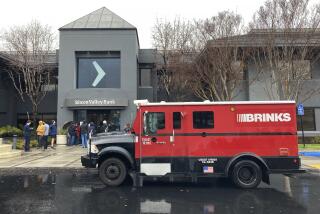S&L; Bailout Bill Soars : Bush’s Rescue Estimate Now as High as $130 Billion : 1,030 Thrifts May Fail; Weak Economy Blamed
- Share via
WASHINGTON — The Bush Administration today dramatically increased its estimates of the cost of rescuing the savings and loan industry, based on a new forecast that as many as 1,030 institutions will fail.
Treasury Secretary Nicholas F. Brady told Congress that the government will need to borrow between $90 billion and $130 billion to clean up the S&L; mess, far higher than the $50 billion in long-term borrowing authority included in the S&L; bailout bill passed by Congress last year.
These estimates do not include the cost of paying interest on the borrowings. When that figure is included, the S&L; bailout cost is expected to top $300 billion.
Brady said the Resolution Trust Corp., which is closing or selling insolvent thrift institutions, could run out of funds by the end of 1990 or early next year.
Brady blamed the increased cost on a weaker economy, particularly in real estate. Slumping real estate prices mean that more S&Ls; are likely to fail since the bulk of their loans are based on real estate prices.
When the S&L; bailout legislation was passed last year, it was believed that between 450 and 550 institutions would fail.
The Administration based its new cost estimate on a belief that between 722 and 1,030 institutions will fail.
Brady stressed that any estimate could be wrong because of the large number of variables. But he said the Administration’s new $90-billion to $130-billion estimate provided a reasonable range of what the ultimate cost will be.
“One could make even bleaker assumptions and make an estimate based on even higher populations of failed thrifts,” he said in testimony before the Senate Banking Committee.
“While such a scenario is theoretically possible, we believe it to be quite unlikely under any reasonable set of economic conditions,” Brady said.
The Administration said that for just the 1991 fiscal year, which begins next Oct. 1, the cost of the S&L; bailout will be $61 billion, almost eight times the projection made in Bush’s budget request to Congress in January.
The higher S&L; bailout estimates were described by one Treasury official as the “largest wild card” plaguing Administration and congressional negotiators trying to reach a compromise on the 1991 budget. The official briefed reporters on condition of anonymity.
The Treasury official said the department was not offering any recommendations on how to pay for the higher costs of the savings and loan bailout, such as new taxes. He said that decision would have to be made in the budget negotiations.
In testimony before the Senate banking committee, Federal Reserve Chairman Alan Greenspan warned that banks should not overreact to the losses suffered on their real estate loans by cutting back on loans.
“There is an overreaction that limited the credit availability for prudent activities,” Greenspan said.
Greenspan said the Fed is carefully monitoring the lending slowdown to make sure it does not hurt the economy. “Our concern is to make certain that what is emerging is contained and to make sure that it does not have a negative impact. Our actions should be precautionary.”
In his testimony, Brady said the government is obligated to protect the savings of millions of Americans who deposited funds in federally insured thrifts that have gone bankrupt.
“Now we make good on that promise,” he said.
The thrift industry has been wracked by regional economic downturns and fraudulent managers in recent years, forcing the government to protect depositors’ savings.
Last year alone, the 2,878 surviving thrifts reported $19.2 billion in total losses, the Office of Thrift Management has said. Hundreds more of them are expected to fail eventually.
More to Read
Inside the business of entertainment
The Wide Shot brings you news, analysis and insights on everything from streaming wars to production — and what it all means for the future.
You may occasionally receive promotional content from the Los Angeles Times.










